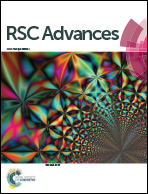Cationic polythiophene for specific detection of cyanide ions in water using fluorometric technique†
Abstract
The toxic cyanide ion has been detected in water at a minimum level of 4.4 ppb (0.17 μM) which is far below the lethal dose. A new water soluble cationic polythiophene graft poly(N,N-dimethylaminoethyl methacrylate) (PTDMA) with iodide counter ion (CPT-I) is synthesised for this purpose. The CPT-I has lower fluorescence intensity than that of PTDMA suggesting excitonic energy transfer from PT backbone to iodide ions. When the iodide anions are substituted by cyanide ions the fluorescence intensity shows an enormous increase depending on its concentration. The increase of the fluorescence intensity remains intact even in the presence of individual or a mixture of other anions e.g. Br−, Cl−, F−, I−, NO3−, ClO4−, OH−, HCO3−, AcO−, CO32−, SO42−, Fe(CN)64−, Fe(CN)63− and SCN−. A histogram of the fluorescence intensity of CPT-I with the addition of 19.6 μM of each of the above anions suggests a nine fold increase in the fluorescence intensity with the cyanide ion whereas other ions exhibit a negligible increase. A calibration curve has been drawn from the addition of different amounts of cyanide ions to the CPT-I solution. CPT-I exhibits very high sensitivity, quick response and high selectivity towards CN− ion over a large number of other anions with a low detection limit in water.


 Please wait while we load your content...
Please wait while we load your content...